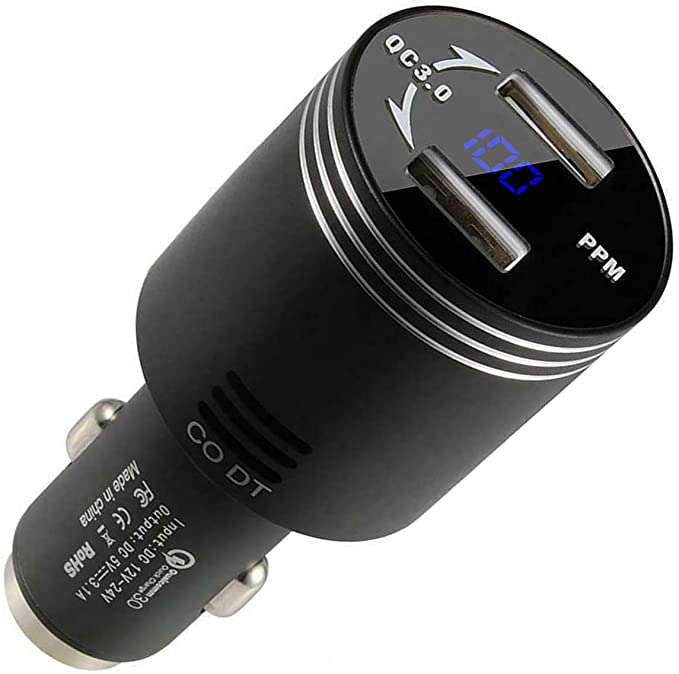Since carbon monoxide (CO) is a colorless and odorless gas, we often overlook CO poisoning as a tangible threat. However, the devastation it can cause is very real. What’s more, the chances of being poisoned by CO are greatly increased in small confined spaces where oxygen is limited. Yes, Buslifers, we are looking at your VW Bus. After all, our homes are no more than three meters long and two meters wide. To put it plainly, this means that a CO leak in our home on wheels will have grave consequences.
So, while our buses bring us freedom and adventure, we also want them to provide safety and security. The first step in achieving this should be to CO-proof our vehicles. In this article, we show you how to do just that. Not only do we discuss the causes and deadly effects of carbon monoxide build-up in your VW Bus, but we also advise you on our recommended preventative measures. Like with anything in life, the more we understand it, the more prepared we can be to tackle it. The great news is that it’s cheap and easy to do.



How carbon monoxide is created and when it becomes a danger
To understand how to prevent carbon monoxide poisoning, we must understand precisely how the compound is formed and where it can be found. This will provide us with a better understanding of how to prevent it from building up inside our homes on wheels.
Carbon monoxide is a by-product of the incomplete combustion of fuels most often used for running engines, stove cookers, and heating systems. Usually, gas-fueled machinery produces carbon dioxide during combustion. If there’s a lack of oxygen to fuel the combustion process, it becomes carbon monoxide. While it is often possible to notice when your cooker of heater is faulty, combustion problems can go unnoticed and that’s when it has the potential to harm you.
Since most of us Buslifers have heating and cooking elements in our living space, our VW Buses are basically a hotbed for the stuff. However, even if you have a basic living setup, the carbon monoxide produced by a faulty engine can still be enough to poison you if it gets trapped inside your vehicle. It is a legal requirement in the US and many other countries across the globe to install a carbon monoxide detector in your home. Now, it doesn’t include a clause for VW Buses, but if your bus is your home then we recommend keeping one in there too if you don’t already. After all, homes are fitted with preventative tools like filters and extractors whereas most of our VW Buses aren’t.
But why is carbon monoxide so scary?
If you haven’t eaten or even worse, not had your morning coffee yet, then we suggest you do before we get into the sobering details of the dangers of carbon monoxide. Ready? Ok. There’s no easy way to put this, but if a carbon monoxide leak goes undetected in your bus, there’s a good chance it will kill you. And since it is a colorless and odorless gas, CO is undetectable to humans, putting us very much at its mercy. No wonder it’s called ‘the silent killer’.
Of course, CO’s deadliness depends on the volume leaking into your bus and the speed at which it is leaking. Small volumes of CO leaking at a slow pace into the bus will cause headaches, dizziness, nausea, chest pain, confusion, and vomiting. Large volumes of CO leaking into your van quickly can knock you unconscious within minutes and, unless someone rescues you, kills you as a result. This may seem a little unbelievable, but CO really is toxic stuff. For perspective, an enclosed space only needs to have a 0.8% CO concentration in the air to knock you out within an hour. Yep, scary.
How does carbon monoxide poison us so easily?
The effects of carbon monoxide on the human body are drastic and devastating. It is inhaled through the air filling your lungs which not only limits your oxygen capacity, but it prevents your body’s cells from being oxygenated. Essentially, it deprives you of oxygen until you suffocate. Apologies for the direct and slightly morbid explanation, but this the unfortunate and very real effect of CO poisoning. Of course, the speed at which the human body suffers from CO poisoning is dependent upon age and health. Children, the elderly, and immunocompromised are likely to have a smaller lung capacity which lowers their CO intake limits. This means they will generally fall unconscious quicker than a healthy adult. However, nobody is immune.



The horrifying reality of CO poisoning
On a dark and cold Christmas Eve somewhere in the middle of wintery England, a husband and wife turned on their central heating to warm up their home. After a while, when the husband realised the house hadn’t warmed up as quickly as it should have done, he decided to go and take a look at the boiler. However, he was feeling dizzy and weak and before he could reach it, collapsed onto the floor. The husband realised that the boiler must be faulty and leaking carbon monoxide, but he was too late. It had already immobilized him. All he could do was call for help.
Luckily, his wife rushed to his side and upon seeing his body on the floor immediately called the emergency services. As the wife waited for an ambulance, she attempted to drag her husband out of the house to safety. However, the carbon monoxide was poisoning her too, and her oxygen-starved body didn’t have the strength to move him. Before long, two unconscious bodies were lying on the floor. They knew they were being poisoned, but it didn’t matter. By the time they realised, they didn’t have the time or strength to fix it. Instead, all they could do was lie in wait and hope they were rescued in time. A short while later, the emergency services arrived and carried the couple to safety. If the wife hadn’t made the call, neither of them would have celebrated another Christmas Day.
This is not isolated
This turbulent tale of a toxic Christmas sounds too tempestuous to be true, but it is. In fact, this is just one of 200 CO-related hospital admissions that happen each year in the UK. In the US, the number rockets to 4,000. Remember, this particular case happened in a home. In a VW Bus, it would have happened quicker, and the consequences may have been grave.
Preventative measures for carbon monoxide poisoning
Keep a carbon monoxide detector in your VW Bus
Being inexpensive and accessible to purchase, there’s no reason not to keep a carbon monoxide detector in your bus. Plus, they’re very small so they don’t compromise your living space. There’s a number of different types of CO detectors, but the standalone (battery or USB powered) and multifunctional USB car adapters are most suitable for vehicles.
Lithium Battery Kidde Carbon Monoxide Detector with Digital Display



Cheffort Handheld Carbon Monoxide Meter



Ibdone Multifunctional USB Port Adaptor with Carbon Monoxide Detector



Get your VW Bus gas-safe
Whether your gas-powered appliances were professionally fitted or not, getting a gas safety check is integral. You can obtain these through plumbing companies and gas safety engineers near you. Be sure to check they are trained to deal with propane first.
Ensure your gas cylinder is properly enclosed
Regardless of how safe your appliances are, you won’t pass your gas safety check unless requirements for gas cylinder storage are met. Your gas cylinder must be secured enclosed in an airtight locker with ventilation. This Van Propane Sytem Guide by Kombi Life should set you on the right track.
Ensure your VW Bus is well ventilated
A well-ventilated bus is beneficial for many reasons, most importantly, to allow the smell of crisp salty air flow into your bus when you’re at the beach. No, wait. It’s to ensure you’re not breathing in any harmful elements that might be floating through the air from CO to mould. If your bus is well ventilated, the chances of you being harmed in the event of a CO leak are much lower than those in a poorly ventilated bus. To learn more about the hows and whys of VW Bus ventilation, read our article on installing a skylight!
Be CO safe, not sorry
Carbon monoxide poisoning is a heavy subject that, if we’re honest, we would rather not have to think about. However, it’s hard to ignore just how life-threatening CO really is. So, we hope this article has raised awareness about the dangers of the compound and encouraged you to manage it if you haven’t already. The safer and more secure our VW Buses are, the more we can enjoy the freedom and adventure they provide.
This is but one thing to remember before heading out on a roadtrip. See our full checklist here.



[…] Nothing says “I care about you” at Christmas to a Buslifer than a carbon monoxide detector. Again, it might not be very exciting, but it is certainly thoughtful. These detectors are an essential yet often overlooked travel essential that will keep your loved ones safe on the road. Read more about their benefits here. […]
[…] Nothing says “I care about you” at Christmas to a Buslifer than a carbon monoxide detector. Again, it might not be very exciting, but it is certainly thoughtful. These detectors are an essential yet often overlooked travel essential that will keep your loved ones safe on the road. Read more about their benefits here. […]